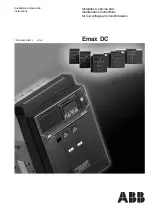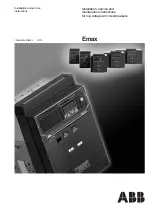
17
Instruction Book
IB182217EN October 2018 www.eaton.com
50 / 75 / 150 DHP [Cable or Hard Bus Application]
Ground and Test Device
SECTION 4: DESCRIPTION AND OPERATION
The G&T is a draw out device that can be inserted into a circuit
breaker cubicle in the same manner as the 50/150DHP Air Circuit
Breaker and Vacuum Replacement Circuit Breaker. It can be ordered
as a single terminal device or a double terminal ground and test
device. Each terminal is isolated from each other and the ground bus
connections by insulating barriers. The upper and lower terminals are
accessible upon opening the respective fronthinged door. The ground
connection is located in the lower section of the device.
m
WARNING
IT IS MOST IMPORTANT THAT THE BUS OR LINE TERMINALS BE
CORRECTLY IDENTIFIED FOR EACH COMPARTMENT BEFORE USING THIS
DEVICE.
Type 50/150DHP manual Ground & Test devices are also available
with either the upper or lower terminals only.
4.1 INSULATING BARRIERS
Insulating barriers are red pieces of GPO-3 glastic material used
to isolate the primary terminals from each other and the ground
connections. They are attached to the ground and test device frame
using insulated hardware. Using other hardware than those provided
will affect the insulating integrity of the ground and test device.
4.2 BUSHINGS AND DISCONNECTING CONTACT
ASSEMBLIES
The upper and lower bushings, which are the primary circuit
terminals of the ground and test device, consist of silver plated
insulated conductors. Multiple finger type primary disconnecting
contacts at the ends of the conductors provides means for
connecting and disconnecting the G&T device to the bus terminals
in the switchgear compartment. (Figure Set 3.3)
4.3 INTERLOCKS
The only interlocks associated with these Ground and Test devices
are the Kirk
®
Key interlocks located on the front of the device. (Figure
Set 3.3) This protects the user from having both top and bottom
hinged doors open at the same time. While either the top or bottom
door is unlocked, the key is unable to be removed from the lock. To
remove the key, close the appropriate door and turn the key. This
will lock the door and the key will now be able to be removed and
inserted into the other lock. This feature is not applicable for single
terminal ground and test.
m
NOTICE
ONLY ONE KEY WILL BE PROVIDED WITH EACH GROUND AND TEST
DEVICE. THIS PREVENTS THE INTERLOCKING MECHANISM FROM BEING
BYPASSED. IF A KEY IS LOST, CONTACT EATON FOR A REPLACEMENT.
THIS FEATURE IS NOT APPLICABLE FOR SINGLE TERMINAL GROUND AND
TEST.
m
WARNING
INTERLOCKS ARE PROTECTIVE DEVICES FOR PERSONNEL AND
EQUIPMENT. DO NOT BYPASS, MODIFY, OR MAKE INOPERABLE ANY
INTERLOCKS. DOING SO COULD CAUSE DEATH, SERIOUS PERSONNEL
INJURY, AND / OR PROPERTY DAMAGE.
4.4 GROUNDING CONTACTS
The grounding contact is an assembly of spring-loaded fingers,
which ground the device by engaging the switchgear cell grounding
bus when the G&T device is levered into the “connect” position. The
ground contact is located at the rear of the device, on the truck, and
visible from the back of the device when out of the cell. (Figure Set
3.3)
Figure 4.2. G&T Device In Connect Position - Position “C”
4.5 BREAKER-CELL CODING PLATES
This is a combination of a notched plate in the cell and interference
bars on the breaker, so that only appropriately rated breakers can be
put into the cell (Figures 4.1 and 4.2).
otee:
N
Code Plates provided on 1200A and 2000A devices only.
m
WARNING
FOR 1200/2000A UNIVERSAL GROUND & TEST DEVICES A CODE PLATE HAS
BEEN FACTORY INSTALLED TO MATCH THE RATING OF THE FACTORY-
INSTALLED PRIMARY DISCONNECTS. ENSURE THAT THE CORRECT
PRIMARY DISCONNECTS AND CODE PLATES HAVE BEEN INSTALLED
FOR THE CORRECT APPLICATION. TO CHANGE THE CODE PLATE SIMPLY
REMOVE AND TURN AROUND SO THAT THE BAR IS POSITIONED AT THE
TOP.
4.6 CELL POSITION DESCRIPTION
Position A: This is the withdrawn position. In the withdrawn position,
the ground and test device is out of the cell. The racking handle is
not required for this position.
Position B: As the G&T device is pushed into the cell, it will reach a
mechanical stop. This is the “disconnect / test” position.
Position C: Continue rotating the racking handle until the rotating
handle turns freely, and the G&T device stops moving. The device
will have reached the “connect” position. (Figure 4.2) Remove the
racking handle.
Figure 4.1. G&T Code Plates (1200A Shown)
5kV
15kV































